The AMD Ryzen Threadripper 3960X and 3970X Review: 24 and 32 Cores on 7nm
by Dr. Ian Cutress, Andrei Frumusanu & Gavin Bonshor on November 25, 2019 9:05 AM ESTGaming: Grand Theft Auto V
The highly anticipated iteration of the Grand Theft Auto franchise hit the shelves on April 14th 2015, with both AMD and NVIDIA in tow to help optimize the title. GTA doesn’t provide graphical presets, but opens up the options to users and extends the boundaries by pushing even the hardest systems to the limit using Rockstar’s Advanced Game Engine under DirectX 11. Whether the user is flying high in the mountains with long draw distances or dealing with assorted trash in the city, when cranked up to maximum it creates stunning visuals but hard work for both the CPU and the GPU.
For our test we have scripted a version of the in-game benchmark. The in-game benchmark consists of five scenarios: four short panning shots with varying lighting and weather effects, and a fifth action sequence that lasts around 90 seconds. We use only the final part of the benchmark, which combines a flight scene in a jet followed by an inner city drive-by through several intersections followed by ramming a tanker that explodes, causing other cars to explode as well. This is a mix of distance rendering followed by a detailed near-rendering action sequence, and the title thankfully spits out frame time data.
There are no presets for the graphics options on GTA, allowing the user to adjust options such as population density and distance scaling on sliders, but others such as texture/shadow/shader/water quality from Low to Very High. Other options include MSAA, soft shadows, post effects, shadow resolution and extended draw distance options. There is a handy option at the top which shows how much video memory the options are expected to consume, with obvious repercussions if a user requests more video memory than is present on the card (although there’s no obvious indication if you have a low end GPU with lots of GPU memory, like an R7 240 4GB).
All of our benchmark results can also be found in our benchmark engine, Bench.
| AnandTech | IGP | Low | Medium | High |
| Average FPS | 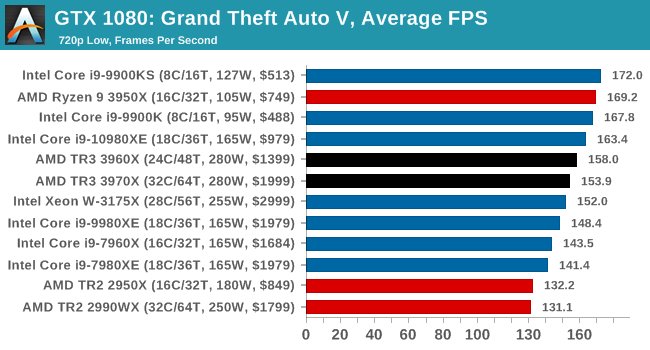 |
 |
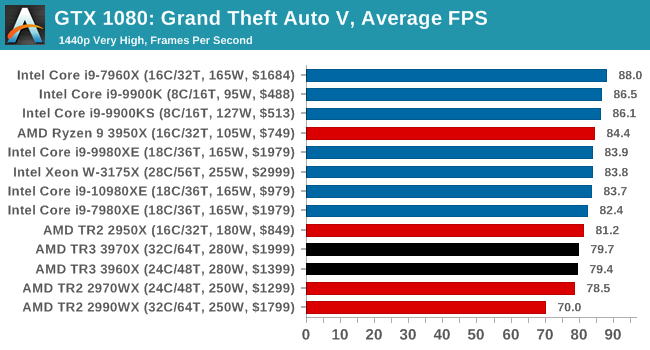 |
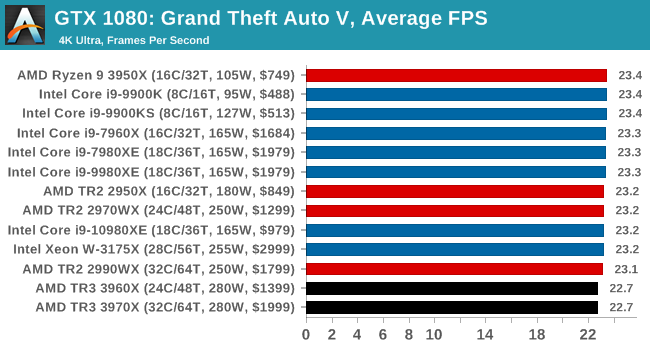 |
| 95th Percentile |  |
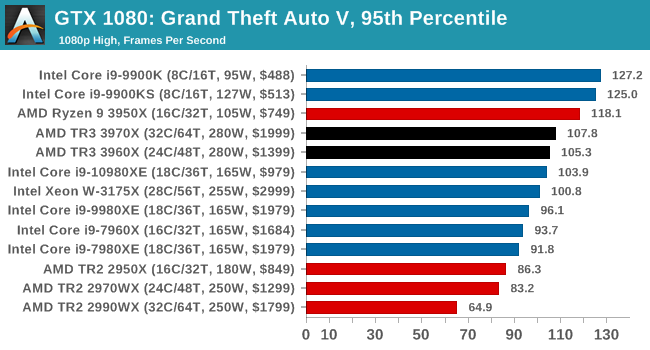 |
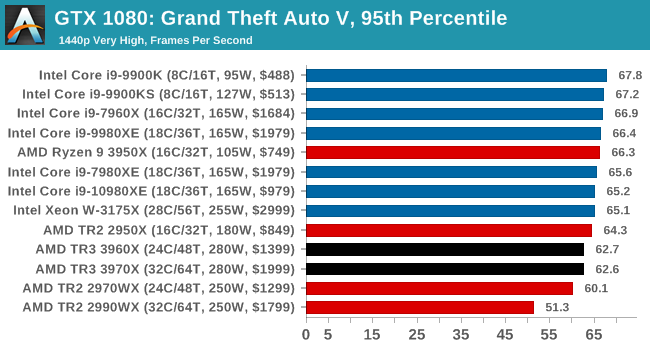 |
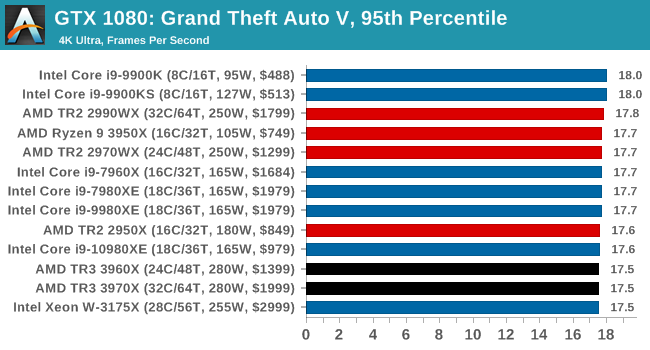 |


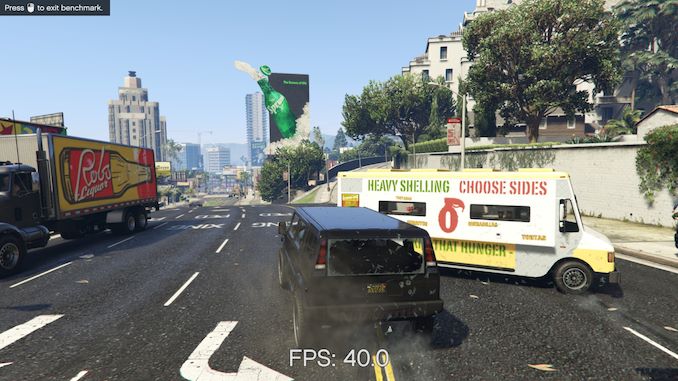









245 Comments
View All Comments
mazz7 - Monday, November 25, 2019 - link
I really thought that Anandtech viewers are smarter than others, but then i see the comments, I am really wrong about that ;pmartixy - Monday, November 25, 2019 - link
The amount of happy this makes me...Also, I'm glad to see y-cruncher in the test suite. It's been my goto power virus/perf benchmark since around the 0.5 versions.
boltcranck - Tuesday, November 26, 2019 - link
World of Tanks enCore is outdated, you should benchmark with the WoT enCoreRTwolfesteinabhi - Tuesday, November 26, 2019 - link
there us a cositant typo at several places .... 3960X is typed as 3950XTorrijos - Tuesday, November 26, 2019 - link
It would be interesting to present all the benchmarks in 2 graphs... The raw results, and then Bench/$.In order to have an idea of the financial benefits.
CraigIsSatoshiBsvIsBitcoin - Tuesday, November 26, 2019 - link
Looking forward to picking up a 64 core CPU for $200 in a couple of years..peevee - Tuesday, November 26, 2019 - link
Don't hold you breath. Well, maybe 64 in-order RISC cores. Not the same at all.liquid_c - Tuesday, November 26, 2019 - link
Gotta love how many people praise AMD and sh*t on Intel for this but just as many seem to forget that when AMD was in Intel’s place, they overcharged *way* more than Intel did / does. As a matter of fact, the 32c/64t gen3 TR costs 200$ more than last gen’s similar offering. The second AMD felt they caught a gust of wind, they slowly started inflating prices.I’m all for competition and i would love it if both Intel and AMD had some sort of control over final pricing (in my country, the 3900x costs ~700$...) but i have this distinct feeling that if things continue at this pace, AMD will become Intel 2.0, pricing and milking wise.
Bottom line - neither of the two are truly consumer friendly but memories fade and time tells its story at a slow pace.
M O B - Tuesday, November 26, 2019 - link
AMD isn't in Intel's place, and the last time there were (2003), they didn't overcharge.As for selling a 32-core CPU for $2000 on a brand new process node that also offers ECC, PCIe 4.0, and is 100W under the closest competitor--that isn't a position Intel has been in before. Even in 2012 Intel wasn't destroying the competition so utterly in single-core, multi-core, node, and feature-set at virtually ever price point.
What Intel will sell you is a 3 year old process node for $2000 like they did for the last 2 years. Rest assured that if Intel was in AMD's shoes right now that 32-core would be $3,000 and not have ECC support.
Plus, AMD has a $750 16-core that is plenty for the enthusiast market. This is truly a workstations CPU.
Xyler94 - Tuesday, November 26, 2019 - link
And Intel gets a pass on the 28 core overclocked Xeon that is priced at almost 4K?Listen, everyone wants to pay nothing for their products. But this chip isn't exactly cheap, and AMD is giving a heck of a deal on a processor Intel can't hope to make with their current processes. Remember that AMD's 64 core behemoth of a CPU only costs 7k, while Intel charges 10K for... 28 cores.